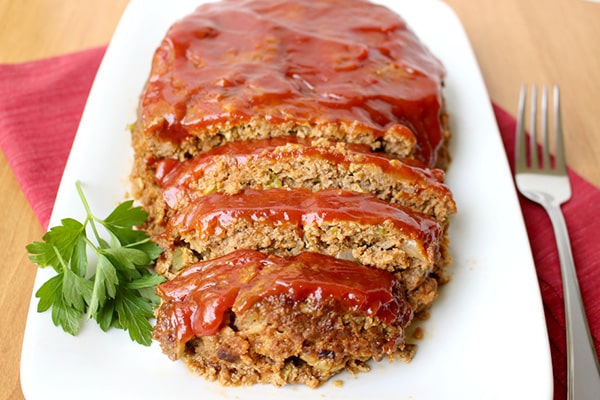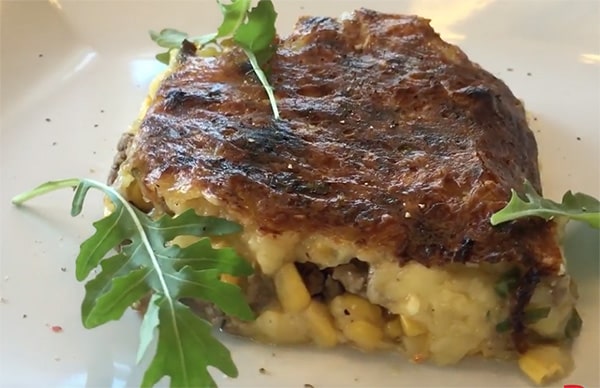Every family has its classics! I don’t know about yours, but in my home growing up there was Dad’s pizza (every Saturday night) and Mom’s meatloaf. It must have been nice for my parents to prepare these meals, knowing they’d get eaten up in no time.
My mother’s meatloaf recipe could be found in a big yellow cookbook, its pages worn and torn by time and the love it had been given. You might even know it: Jehane Benoit’s Encyclopédie de la cuisine Canadienne (Encyclopedia of Canadian cuisine). There was everything in this book; it was the Bible of family cooking. And on page 98 (of the 1963 edition), there was the recipe for my mother’s oh so succulent meatloaf. Tender and juicy meat with a sweet and spicy tomato glaze: it was excellent!
I find it fascinating that we enjoy these complex and elaborate recipes when we go to the restaurant, and yet find so much comfort and enjoyment in such a simple dish at home. Because let’s admit it, the meatloaf has a very humble background. Many countries have their own version, often made with leftover meat, offal, spices and bread. A bit like Scottish haggis. For us, the recipe arrived with the French, then evolved with the English, to finally become a typical Québécois dish around the 1920s-1930s. During the war and the economic crisis, meat was scarce, but everybody still needed to eat. So to offer a nourishing meal, mothers had the idea to add eggs, milk and bread or cereal to their mixture of meat and spices. The family meatloaf was born.1
It may be simple, but good preparation is still key, otherwise it can quickly become dry and unpleasant.
Jehane Benoit used beef in her meatloaf. My mother never did. Oh wait, she did just once, only to try it and realize she never would again. Unless you pick a fatty ground beef, the result will be too dry. Ground veal gives excellent results, as does ground pork. If you want to use white meat, go for ground chicken instead of turkey for the same reason as mentioned above: when cooked, turkey renders a much drier result. To spice up the taste of your meatloaf, add a portion of sausage meat to your ground meat… you’ll see, it’s delicious!

The choice of meat definitely has a major impact on taste and texture, but the added ingredients to make the mixture homogenous are what make the recipe incomparable. Bread crumbs, oats, corn cereal or fresh bread, whatever suits your fancy! The secret is to let those ingredients sit and soak up the milk before adding them to the meat mixture. One day, wanting to go quickly, I poured the milk over the breadcrumbs and waited for the bread to be just a little moist before mixing it with the meat and putting it in the oven. The result revealed that the art of cooking takes time. My meatloaf had a grainy texture instead of being moist and juicy. It tasted good, but not as good as usual. So it’s important to let bread or breadcrumbs soak up the milk or cream before adding them to the rest of the ingredients.
Spices also add character to your recipe. Nowadays, in addition to onions and garlic, we have access to an impressive variety of spices, which gives us plenty of choice when concocting a dish. With red meats, think marjoram, oregano, and thyme. For pork, try curry, coriander, and sage. If you prefer veal or chicken, go for oregano, paprika, chives or tarragon. You’ll see, the result will be superb!
And about that famous sauce that is poured on top of the meatloaf before cooking, it has a function much more important than simply adding colour and taste: it will protect your meat from getting too dry over the long time spent in the oven. That’s also the reason why a little dry mustard is often added because mustard has the property of helping prevent the evaporation of liquids. It creates a protective barrier. The traditional sauce is made with tomatoes or a mixture of ketchup, sugar and spices, but just browse the Internet a little and you’ll discover the variety of sauces that could give a festive feel to this dish that is, all in all, rather ordinary. How about topping it with a wild mushroom or three pepper sauce? Or what about preparing it au gratin, with cheese melted on top? Other funky options include a Mexican style meatloaf with a mixture of chili spices and a salsa style sauce, or a cheesy meatloaf, with your favourite cheese baked at its centre. Have you ever considered mixing in fruit? I’m thinking pork and apples with a maple sauce… yummy! Are you hungry yet?
Meatloaf is cooked slowly in a traditional oven or slow cooker, which gives it its delicious texture and allows the spices to develop their full aroma. In the oven, on medium heat, it’s ready in about 60 minutes if it’s placed in a traditional bread pan. In the slow cooker, it takes 5-6 hours on low heat.
If, like me, you like to experiment and want a mix of flavours for a special occasion like, say, Christmas, why not make a Christmas log-shaped meatloaf? I tried it! And it was delightful! I chose turkey (for a traditional Christmas feel), pork, ground beef and Italian sausage meat. I placed the sausage in the form of a roll that I put in the centre of the turkey section. I then put the whole thing on a bed of beef to create a beautiful contrast of colour and I finished my roll with a layer of pork. This created a beautiful Christmas meatloaf that I topped with a maple sauce. It’s definitely easier said than done, but the result is worth the effort, believe me! It was beautiful when sliced in the presentation platter, delicious, and smooth on the palate. The sausage spice mixed with the subtler turkey taste and the sweet glaze… fantastic.
The beauty of meatloaf is also in the next day. With the leftovers, you can make a sandwich, a burger or eat it with a salad! If you do have leftovers, I bet they won’t stay in your fridge for long! Happy cooking!
1 Michel Lambert in his book, Histoire de la cuisine québécoise (History of Quebec Cuisine).


